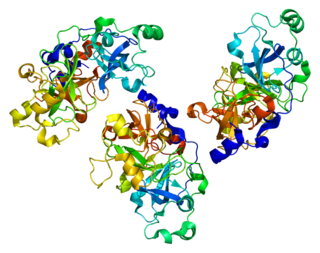
Leucine-rich repeat-containing G-protein coupled receptor 6 is a protein that in humans is encoded by the LGR6 gene. Along with the other G-protein coupled receptors LGR4 and LGR5, LGR6 is a Wnt signaling pathway mediator. LGR6 also acts as an epithelial stem cell marker in squamous cell carcinoma in mice in vivo.

EGF-containing fibulin-like extracellular matrix protein 1 is a protein that in humans is encoded by the EFEMP1 gene.

LUC7 like 3 pre-mRNA splicing factor (LUC7L3), also known as Cisplatin resistance-associated overexpressed protein, or CROP, is a human gene.

Required for meiotic nuclear division 5 homolog B , also known as RMND5B, is a protein which in humans is encoded by the RMND5B gene. It has a zinc finger domain and is highly conserved throughout many eukaryotic organisms.

Leucine-rich repeat-containing protein 4 is a protein that in humans is encoded by the LRRC4 gene.

F-box/LRR-repeat protein 5 is a protein that in humans is encoded by the FBXL5 gene.

Prolargin is a protein that in humans is encoded by the PRELP gene.

Leucine-rich repeats and death domain containing, also known as LRDD or p53-induced protein with a death domain (PIDD), is a protein which in humans is encoded by the LRDD gene.

Lethal(3)malignant brain tumor-like protein is a protein that in humans is encoded by the L3MBTL gene.

Leucine-rich repeat-containing protein 41 is a protein that in humans is encoded by the LRRC41 gene.

Beta-catenin-like protein 1 is a protein that in humans is encoded by the CTNNBL1 gene.

Amyotrophic lateral sclerosis 2 chromosomal region candidate gene 8 protein also known as calcium-response factor (CaRF) is a protein that in humans is encoded by the ALS2CR8 gene.

E3 ubiquitin-protein ligase LRSAM1, previously known as Tsg101-associated ligase (Tal), is an enzyme that in humans is encoded by the LRSAM1 gene.

DnaJ homolog subfamily C member 10 is a protein that in humans is encoded by the DNAJC10 gene.

Leucine-rich repeat neuronal protein 1 is a protein that in humans is encoded by the LRRN1 gene.

Importin-11 is a protein that in humans is encoded by the IPO11 gene.

Leucine-rich repeat transmembrane protein FLRT3 is a protein that in humans is encoded by the FLRT3 gene.

Mannose-1-phosphate guanyltransferase beta is an enzyme that in humans is encoded by the GMPPB gene.

Leucine-rich repeat and calponin homology domain-containing protein 4 is a protein that in humans is encoded by the LRCH4 gene.

Leucine-rich repeat-containing protein 8C is a protein that in humans is encoded by the LRRC8C gene. Researchers have found out that this protein, along with the other LRRC8 proteins LRRC8A, LRRC8B, LRRC8D, and LRRC8E, is sometimes a subunit of the heteromer protein Volume-Regulated Anion Channel. Volume-Regulated Anion Channels (VRACs) are crucial to the regulation of cell size by transporting chloride ions and various organic osmolytes, such as taurine or glutamate, across the plasma membrane, and that is not the only function these channels have been linked to.

















